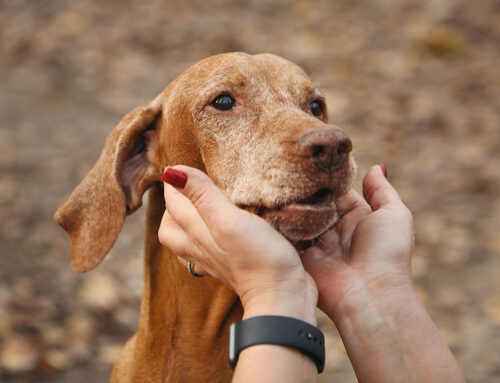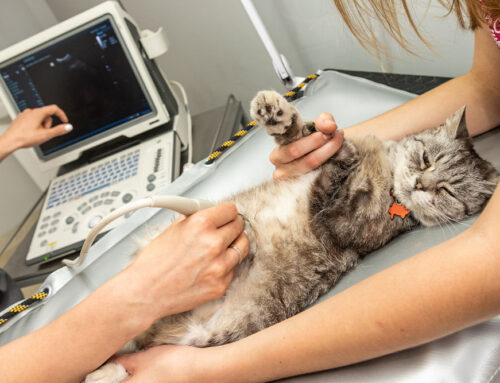When we dream about sharing our lives with pets, we envision peaceful evenings snuggled on the couch or leisurely strolls in the park. However, reality may be less than idyllic, such as when you catch a whiff of cat urine while relaxing on the couch, or when you feel like an Iditorad sled being dragged through the park, when you had hoped for a leisurely stroll.
Pet owners’ commonly complain about their pets’ inappropriate behaviors. As dogs and cats try to live harmoniously in a human household, conflicts and confusion are almost guaranteed. Fortunately, Burlington Veterinary Center offers many suggestions on how to redirect your pet’s unwanted behaviors, and how to train them to behave appropriately, managing with patience, planning, and positivity.
Medical versus behavioral issue: Talk with your veterinarian
If your pet is demonstrating uncharacteristic, progressively worsening, or dangerous behavior, schedule an appointment today. Many serious medical issues can cause changes in personality and require veterinary intervention. If your pet is a puppy or kitten, call us to discuss their behavior, so we can determine whether the problem is normal and age-appropriate, or requires further investigation.
Once medical causes are ruled out, your veterinarian will discuss with you some possible remedies or training solutions.
Problem: My pet is constantly begging, and at times snatches food from the kitchen counter
Solution: Begging is a potent behavior that exists on an intermittent reinforcement schedule. Similar to the addictive possibility of winning a slot machine’s jackpot, begging’s results are also unpredictable, meaning pets cannot predict when they will win the prize. This variability makes begging difficult to eliminate, but you can help your pet stop begging through dedication and patience.
Some steps to resolve begging include:
- Agreeing to cooperate — The biggest challenging aspect to resolve begging is to convince all household members to agree to stop rewarding the behavior.
- Training a “settle” behavior — Teach your pet to relax during meals on a designated bed or rug, or in a crate.
- Increasing exercise — Physically and mentally satisfied pets are less likely to beg.
- Scheduling a nutrition consultation — If your pet is not satisfied with their food, they may feel like they are starving. Our veterinary staff is always available to discuss your pet’s nutritional needs.
Problem: My pet is chewing on everything and scratching the furniture
Solution: Chewing and scratching can be a costly behavior that may result in property damage and your pet’s physical harm if they swallow something other than food. Resolve chewing and scratching by redirecting the behavior, and carefully managing your pet’s environment by doing the following:
- Providing items appropriate to the behavior — Supply a variety of pet-safe chew toys and scratching posts to prevent your pet from chewing or scratching household items.
- Limiting their opportunities — Use crates, pens, and gates to control your pet’s access to areas where they will not be tempted to chew or scratch.
- Removing hazards — Establish a pet-proof area free from appealing items and potential toxins.
- Trimming your cat’s nails — Trim your cat’s nails frequently to reduce their need to scratch for self-grooming, and to lessen the damage they may cause when they scratch.
- Eliminating boredom — Destructive behavior can emerge from boredom, so engage your pet with puzzle toys, play, outdoor activity, and training games.
If your pet is destructive only while you are away, give us a call. Dogs and cats who demonstrate inappropriate behavior in their owners’ absence may be experiencing separation anxiety, which requires veterinary-supervised treatment.
Problem: My pet is having accidents in the home
Solution: After ruling out a medical cause, take a pet’s-eye view of elimination opportunities. Do you take your dog outside frequently? Is your cat’s litter box easily accessible, or do they have to climb stairs to access the box? The following recommendations may help your pet avoid having accidents in the home:
- Deep cleaning previous accident spots — Eliminate all traces of odor with an enzymatic pet cleaner.
- Determining marking behavior — If your pet is urinating on vertical surfaces or leaving only a few droplets, this is marking behavior, not eliminating. Identify and remove your pet’s stress trigger, if possible.
- Rewarding puppies and dogs for correct behavior — Treat or play with your pup after they successfully eliminate in the appropriate location.
- Avoiding punishment after an elimination accident — Punishment can create fear and anxiety, and also cause pets to hide their behavior.
Problem: Your pet is growling, hissing, lunging, or biting
Solution: If your dog or cat is responding to people, pets, or environmental changes by acting aggressively, seek professional guidance from a certified veterinary behaviorist or a reinforcement-based trainer. Reactivity, resource guarding, and aggression are complex issues that can escalate quickly and lead to physical injury. Do not attempt to correct these issues on your own.
Problem: Your dog is barking at everything

Solution: Barking is a self-reinforcing behavior with causes that most commonly include demanding (i.e., attention seeking), alert barking, and boredom. Barking is not only a nuisance, but also can threaten your living arrangement if people in close proximity are annoyed by the noise. Help your hound learn to hush by trying the following tips:
- Putting an end to yelling — A yell sounds like a bark. When you yell, you are simply encouraging your dog to bark more.
- Cuing barking — Teach barking as a trick, and reward your pet only when they bark on cue. Likewise, teach “Quiet” by rewarding your dog between bark cues.
- Teaching “look at that” — If your dog barks at a visual stimulus, observe the stimulus from a distance and rapidly feed your dog tiny rewards for simply looking. After several repetitions (i.e., looking, treating), your dog should look at the stimulus and then look back at you. Praise and reward. Through this game, your dog learns that looking quietly is more valuable than barking, which encourages them to voluntarily disengage.
If you need assistance with your pet’s behavior, every Burlington Veterinary Center team member is Fear-Free certified and can provide helpful advice. We can also recommend positive reinforcement-based trainers in our area.
Remember, if your pet is demonstrating uncharacteristic or unpredictable behavior, they may be experiencing a medical issue, so schedule an appointment with us before trying at-home behavior modification techniques.







Leave A Comment